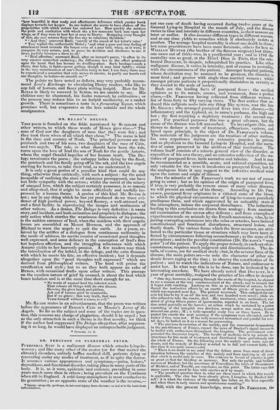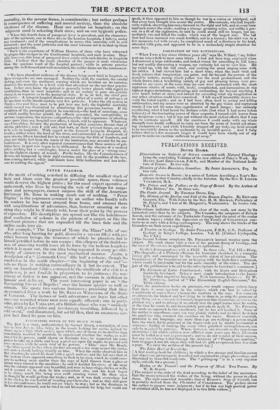DR. FERGUSON ON PUERPERAL FEVER.
PCERPERAL fever is a malignant disease which attacks lying-in- women ; and like ninny other of the neuter (or for that matter the chronic) disorders, entirely baffles medical skill, patients dying or recovering under any modes of treatment, as if to spite the doctor. It assumes various appearances and symptoms,—pains, lesions,* depositions, and functional disorder, taking place in many parts of the body. It is, as it were, epidemic and endemic, prevailing in some years much more than in others ; being prevalent on the Continent when rife in England. A cold damp atmosphere is most conducive to its generation ; as an opposite state of the weather is the reverse,— • fsjury—properly, perhaps, hi internal injury from disease; as lesiA in the brain from 30fiummotion. not one ease of 'death having occurred during twelve years at the General Lying-in Hospital in the month of July, and the disease varies in time and intensity in different countries, as their seasons ars later or earlier. It also assumes different types in different seasons, and at one time yields to remedies which it obstinately resists at another. The average hospital mortality is about one death in thee; but some practitioners have been more fortunate, others (hr less so, WILLIAM HUNTER (the brother of the famous surgeon) lost thirty. one -cases out of thirty-two, in a pestilential year ; and in 1782 the mortality was so great, at the Hotel Dieu in Paris, that the cele- brated DOULCET, In despair, relinquished his practice. Like other malignant disease, it varies in intensity, and of course in mortality, with the circumstances of the patient. Amongst hospital patients, whose destitution may be assumed to be greatest, the disorder is most distal ; and greater with single than married women ; whilst amongst private patients it proportionally diminishes in severity as they ascend in the scale of society. Such are the leading facts of puerperal fever : the medical opinions as to its nature, causes, and treatment, form a perfect chaos,—Dr. FERGUSON having collected from different writers a list of from forty to fitly varying views. The first author that re- duced this intligesta moles into any thing like system, was the late Dr. Gomm ; who arranged puerperal fever into two classes,—the inflammatory and the typhoid, or, in nurse's parlance, the high and low ; the first requiring a depletory treatment ; the second sup- port. For practical purposes this was a great advance, but the cause of the disease was left untouched. To investigate this, and thence to deduce a mode of treatment, efficacious, various, and based upon principle, is the object of Dr. FERGUSON'S Whittle, The materials of his judgment are the treatises of other authors, his own experience during an extensive practice in private and as physician to the General Lying-in Hospital, and the num- tive of cases preserved in the archives of that institution. The volume itself consists of a minute general view of the disorder, an exposition of his own theory, and an extensive collection of the sta- tistics of puerperal fever, both narrative mid tabular. And it may be recommended as a sensible, acute, and rational exposition, not only valuable for the views it inculcates on puerperal fever, but for the analogous hints it may suggest to the reflective medical mind upon the nature and origin of disease. Into the minutite of Dr. FERGUSON'S work we are not of course going to enter ; but as his opinion of the origin of puerperal fever, if true, is very probably the remote cause of many other diseases, we will present an outline of his theory. According to Dr. FER- GUSON, puerperal fever originates in a vitiated state of the blood, to which the physical circumstances of lying-in-women peculiarly predispose them, and which aggravated by an unhealthy state of the atmosphere, induce the corporeal disturbance. 'lime inductions leading to this conclusion are drawn from analogy; from anatomi- cal examination of the uterus after delivery ; and from examples of experiments made on animals by the French anatomists, who, by in- jecting corrupting substances into the veins or arteries, have induced constitutional and functional disturbance, structural lesion, and finally death. The various forms which the fever assumes, are attri- buted to the particular tissue or structure which may have been af- fected by circumstances following accoucheinent ; to the state of the atmosphere ; and to the peculiar constitution (Dr. DICKSON'S "weak point") of the patient. To apply the proper remedy, in each set ofeir- cumstances, requires much judgment and discrimination. The de- tails, of course, are for medical study ; but, in the severer form of the disease, the main points arc—to note the character of other epi- demic fevers raging at the time ; to observe the constitution of the
patient; and to watch the indications of Nature, and endeavour to assist her. In what way this is to be done, can be indicated by an
interesting anecdote. We have already noted that DOCLCET, in a year of great mortality, resigned the practice of his office in despair.
" One day, however, in passing through the wards of the hospital, he chanced to see a woman at the very commencement of the attack, and to remark that it began with vomiting. Looking on this as an indication of nature, he fur- thered the instinctive efforts by an emetic of fifteen gran ; of ipeeactianha, which was repeated next day. The patient recovered. This unhoped-for suc- cess led him to try it on all the rest, and two hundred were saved ; while six, who refused to take the emetic, died. Its treatment, when methodized, con- sisted of giving fifteen grains of ipeencuanha, repented in an hour. The last dose acted generally on the bowels ; an action which he sustained by a potion consisting of old amygdal. two drachms, syrupi =Ivai one ounce, kermes mineral one grain ; M.; a table-spoonful every two or three hours. Ile re- peated the emetic the next morning if the symptoms were alleviated, and the rather if they were not. If the belly remained meteorised aud painful for seve- ral days, he looked on it as a reason for persevering. " 'rile previous devastation of the malady, and the consequent despondency in the practitioners of France, caused the news of Douleet's signal success to be hailed with enthusiasm throughout the kingdom. The government com- pensated the discoverer largely. The tinnily ot medicine thew up minute in- structions fin this mode of treatment, and aiatributed them gratuitously over the whole of France. On the following year the malady once more was epi- demic, and the remedy of Doulcet resorted to in full and earliest faith; bat this time it was quite unsuccessful. " There is 310 doubt in ins mind that the failure arose from want of discri- mination between the varieties of this malady and from applying in all cases that which is useful only in some. The evidence in favour of emetics is quite as great as that for bleeding or mercury. Not only the public and brilliant success of Doulcet, hut the assertions of Cruvelhier, the trials of Desormeaux, of Richter, and of Tone116, are conclusive on this point. The latter says that many cases were cured by hint with emetics as if by magic. " The practical question then is, what are these cases in which this remedy is applicable. Tine clue has been already given, I imagine, by Douleet hint -
self it is when the violence of the malady has lidlen on the liver especially, and when there is early nausea and spontaneous vomiting."
Still, with the present knowledge, even of Dr. FERGUSON, the mortality, in the severer forms, is considerable ; but rather perhaps in consequence of suffering and mental anxiety, than the absolute virulence of the disease. Hear our author on hospitals ; on the udgmcnt used in selecting their sites; and on our hygienic police. " When this fourth form of puerperal finer is prevalent, and the character- istic of the epidemic, one in three dies in the London hospitals, I believe, under anv treatment ; and if the complications be many, this mortality will be still increased ; and the most judicious and the most humane act is to shut up these receptacles forthwith. " Such is the experience of William limiter, of those who have witnessed its plague-like ravages in the Continental hospitals and such is mine. Hap- pily, however, this form of puerperal fever exists witl, such flitality in hospitals Blew. I believe that the single chamber of the pauper is more wholesome than the spacious ward of the hospital patient ; while in private practice among the well-housed and well-nourished, the milder forms are the commonest.
tt We have abundant evidence of the disease being most fatal in hospitals as these receptacles are now tnattaged. Neither the skill, the comfort, the careful dieting, and event he assiduous nursing which are lavished on its inmates, diminidt the mortality to a level with that attendant on the out-duor popula- tion. In her own home the patient is generally better placed, with regard to ventilation, than in most hospitals; and in no malady is pure air, quickly changed, Cu requisite as in the puerperal state. It is, in fitet, the chief pro- phylactic. A lying-in hospital should consist either of a series of cottages, or its spacious wards should contain very few patients. Under the old system ill France, two and three used to be put into one bed; the frightful mortality which ensued was diminished by abandoning this perilicious custom. If the condition of the puerperal patient be considered,—the load of secretions, bOille Of Which readily become putrid, the effluvia generated, the susceptibility to nervous impression, the nervous exhanstion,—the vital importance of ttifor'ding more space t hi itany Ill/Spit:a now offers, 1 think, will be apparent. Whatever, says Cravelhier, .favours the production of hospital gangrene, %yours that of uterine phlebitis ; and, I will add, that both, in their severest forms, are only to be in hospitals. With regard to the General Lying-in Hospital, its locality, rather below the level of the river, and surrounded by a mesh-work of ern sewers, fifteen hundred feet in extent, receiving the filth of Lambeth, and seine not thirty feet front the wards of the institution' may account for its un- healthiness. It is only after repeated remonstrances that these sources of pol- lution have in part now begun to be obliterated. ln the absence of a medical nothing but a catastrophe known under the ,odoss of a strong case,' has the slightest chance of remedy. Public bodies, like the Commissioners of Sewers, are hampered by their rigid customs, amid by the penalties of the law, from coming forward, while individuals have little inclination and less inthi- eace in making the appeaL"



























 Previous page
Previous page